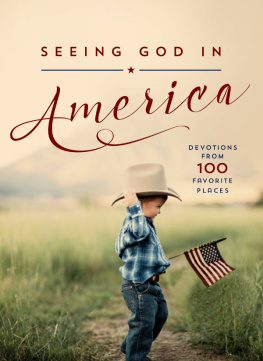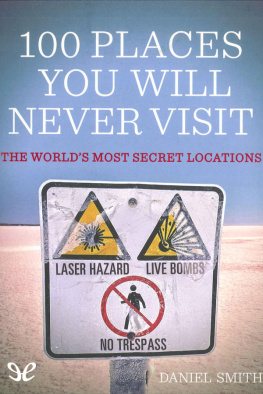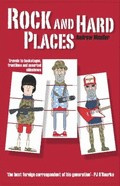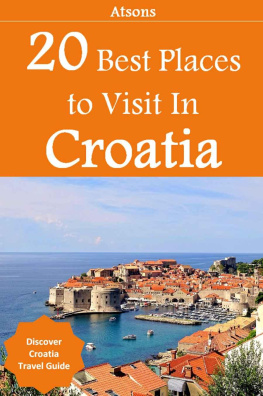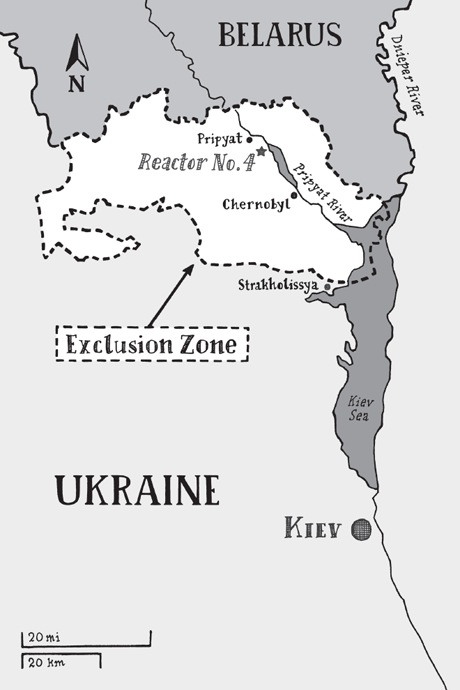
ONE
VISIT SUNNY CHERNOBYL
It began on a train. Vienna to Kiev, rocking back and forth in a cabin of the Kiev Express. There was a certain Agatha Christie-meets-Leonid Brezhnev charm to it. Long oriental rugs ran the length of its corridors, and the passenger compartments were outfitted with a faux wood-grain veneer and dark red seats that folded up to form bunks.
Its not actually called the Kiev Express. If it were an express, it wouldnt take thirty-six hours. In fact, train is no way to make this trip. I bought my ticket only because I believed, unaccountably, that Vienna and Kiev were close to each other. They are not.
I was going to Chernobyl, on vacation.
Trains are for reading, and I had brought a pair of books: Voices from Chernobyl, a collection of survivor interviews, and Wormwood Forest, an investigation of the accidents effect on the environment. I recommend them both, although when I say that trains are for reading, I dont mean that I was doing all that much. Really I was taking an epic series of naps, sporadically interrupted with books.
My companion in the passenger compartment was Max, a rotund, smiling man in his early thirties. Max spoke in a high, oddly formal voice and looked like a grown-up Charlie Brown, if Charlie Brown had grown up in the USSR. Originally from Kiev, he now worked in Australia as a computer programmer. He had an endearing way of stating the obvious. I would wake up from a nap, my book sliding onto the floor, and look out the window to see that we had stopped in a station.
We have stopped, Max would say.
We spent the first night crossing the length of Slovakia. A beautiful dusk settled over the cracked smokestacks of deserted factories.
In the morning, we reached the Ukrainian border and rolled into a cluttered rail yard, coming to rest between a set of oversize jacks, taller than the train car itself. A team of crusty rail workers set themselves wrenching and hammering at the wheels of the train, and soon the jacks were raising the entire car into the air, leaving the wheel trucks beneath us on the rails.
The train tracks in the former Soviet Union dont match those in Europe, you see. So they were changing the wheels on the train.
They are changing the wheels on the train, Max said.
By afternoon we had entered the flowered alpine landscape of the Carpathian Mountains, and Max had become curious about my plans. I chose not to tell him that I was embarking on an epic, years-long quest to visit the worlds most polluted places. I just said I was headed for Chernobyl.
His face lit up. He had stories to tell. In the spring of 1986, when word of the disaster got out, he was eleven years old, living in Kiev. Soon, people were trying to get their children out of the city. It was nearly impossible to get train tickets, Max said, but somehow his family got him onto a train bound southeast for the Crimea. Even though tickets were so hard to come by, the train was nearly empty, and Max implied that the government had manufactured the ticket shortage to keep people from leaving the city.
When we arrived, he said, the train was surrounded by soldiers. They tested everyone and their things for radiation before allowing them to move on. They were trying to keep people from spreading contamination.
He stayed away from Kiev that entire summer. From his parents, he heard stories about life in the city during those months. The streets were washed down every day. Bakeries that had once left their wares out in the open on shelves now wrapped them in plastic.
Max talked about the possibility that cancer rates in the area had increased because of Chernobyl, and he told me that his wife, also from Kiev, had abnormalities in her thyroid, which he attributed to radioactive exposure.
Its very lucky Kiev didnt get more radiation, thanks to the winds, he said. Then, in his very polite, clipped voice, he asked, And what do you think about nuclear energy?
That night I lay restless in my bunk and imaginedas only an American canthe post-Soviet gloom slipping by outside, felt the train shudder as it pushed through the thick ether left behind by an empire. In the book of Chernobyl survivors stories, I read an account by a firefighters widow. They were newly married when her husband responded to the fire at the reactor. One of the first at the scene, he received catastrophic doses of radiation and died after two weeks of gruesome illness.
Desperately in love, his wife had snuck into the hospital to accompany him in his ordeal, even though his very body was dangerously radioactive.
I dont know what I should talk about, she says in her account. About death or about love? Or are they the same?

Kiev is a beautiful city, a true Paris of the East, a charming metropolis whose forests of horse chestnut trees set off its ancient churches and classic apartment buildings like jewels on a bed of crumpled green velvet. The trick is to come in the summertime, when a warm breeze blows across the Dnieper River and the bars and cafs spill out into the gentle evening. You can stroll down the Andriyivskyy Descent, lined with cafs and shops, or explore the mysterious catacombs of the Pechersk Lavra, with its menagerie of dead monks. Or you can dive into the citys pulsing downtown nightlife.
I went straight for the Chernobyl Museum.
Theres a special blend of horror and civic pride on display at any museum dedicated to a local industrial disaster, and the Chernobyl Museum is surely the best of its kind. The place incorporates history, memorial, commentary, art, religion, and even fashion under a curatorial ethos that is the mutant offspring of several different aesthetics.
In one of the museums two main halls, I found a bizarre temple-like space. Soothing Russian choral music emanated from the walls. In the center of the room lay a full-size replica of the top face of the infamous reactor. A dugout canoe was suspended above it, heaped with a bewildering mixture of religious images and childrens stuffed toys. I tried to understand the rooms message, and could not. Empty contamination suits lingered in the shadows, arranged in postures of bafflement and ennui.
The second hall housed a definitive collection of Chernobyl memorabilia, as well as a tall aluminum scaffold hung with mannequins wearing nuclear cleanup gear. They seemed to be flying in formation, a squad of unusual superheroes. Their leader, arms upraised, wore a black firefighting suit with large white stripes and a metal backpack connected to a gas mask. Through the bubble of the helmets face guard, I could just make out the cool, retail gaze of a female head, with full eyelashes and painted plastic lips.
Underneath, there was a cross-sectioned model of the reactor building in its pre-accident state. As I peered into it to get a view of the reactors inner workings, two docents lurking by the door noticed my interest. Moving with the curt authority of guards, they rushed forward to turn the model on, groping at a control panel attached to the base. The model reactor glowed warmly, showing the normal circulation of water in the core. But the women were unsatisfied. Fussing in Ukrainian, they began flipping the switch back and forth, wiggling and slapping the little control panel with increasing fervor. Finally, they jiggled the switch just right, and the rest of the reactors systemswater and steam pipes, cooling systems and boilersflickered to life.

Next page


